display DODGE RAM SRT-10 2006 Service Repair Manual
[x] Cancel search | Manufacturer: DODGE, Model Year: 2006, Model line: RAM SRT-10, Model: DODGE RAM SRT-10 2006Pages: 5267, PDF Size: 68.7 MB
Page 4925 of 5267

B105C–RECIRCULATION DOOR TRAVEL RANGE TOO SMALL
For a complete wiring diagramRefer to Section 8W.
Theory of Operation
The A/C Heater Control calibrates each actuator individually. Automaticcalibration occurs upon power up after
installing a new A/C Heater Control. Manual calibration occurs by sendinga command with the scan tool. The pur-
pose of actuator calibration is to determine the total span of door travel between physical stops. To calibrate the
actuator, the A/C Heater Control first moves the door to an end stop, and then counts the number of pulses it takes
to move the door to its other stop. An expected range of span is stored in the control’s memory. If the measured
calibration value is less than the expected range for this actuator, this DTC will set. Note thatthe control clears all
stored calibration faults at the beginning of the calibration procedure.
When Monitored:
During actuator calibration.
Set Condition:
If the total span of the Recirculation Door is less than the low range limit.
Possible Causes
DOOR DRIVER ELECTRICAL CIRCUIT(S)
RECIRCULATION DOOR SEIZED, BINDING, OBSTRUCTED
RECIRCULATION DOOR ACTUATOR
A/C HEATER CONTROL
Diagnostic Test
1.CHECK FOR ACTIVE CONTROL CIRCUIT/PERFORMANCE DTCs
Turn the ignition on.
With the scan tool, read active HVAC DTCs.
Does the scan tool display any active: XXXX CONTROL CIRCUIT/PERFORMANCE DTCs?
Ye s>>
Diagnose and repair the DTC(s). Refer to the Table of Contents in this Section for a complete list of
HVAC related symptoms.
No>>
Go To 2
2.CHECK FOR ACTIVE CONTROL CIRCUIT OPEN DTCs
With the scan tool, read active HVAC DTCs.
Does the scan tool display any active: XXXX CONTROL CIRCUIT OPEN DTCs?
Ye s>>
Diagnose and repair the DTC(s). Refer to the Table of Contents in this Section for a complete list of
HVAC related symptoms.
No>>
Go To 3
3.RUN THE ACTUATOR DTC DETECTION TEST
With the scan tool in HVAC, select System Tests and then select Actuator DTCDetection. When the test is com-
plete, select View DTCs.
Does the scan tool display any DTCs?
Yes, Dual-Zone System
Diagnose and repair the DTC(s). If multiple DTCs are present, beginning with the passenger blend door,
diagnose and repair all short high DTCs and then all short low DTCs. Refer tothe Table of Contents in
this Section for a complete list of HVAC related symptoms.
Yes, Single-Zone System
Page 4926 of 5267
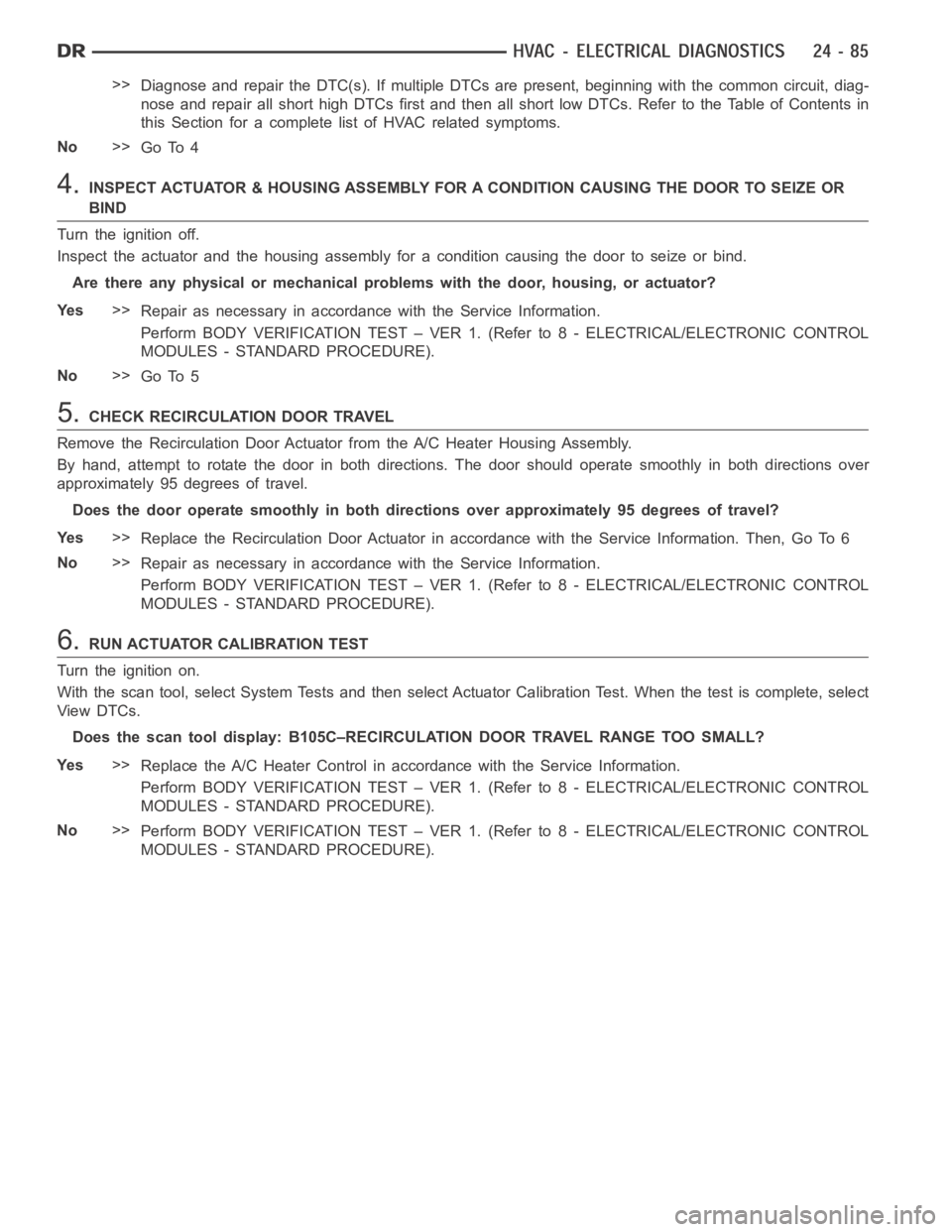
>>
Diagnose and repair the DTC(s). If multiple DTCs are present, beginning with the common circuit, diag-
nose and repair all short high DTCs first and then all short low DTCs. Refer to the Table of Contents in
this Section for a complete list of HVAC related symptoms.
No>>
Go To 4
4.INSPECT ACTUATOR & HOUSING ASSEMBLY FOR A CONDITION CAUSING THE DOOR TO SEIZE OR
BIND
Turn the ignition off.
Inspect the actuator and the housing assembly for a condition causing the door to seize or bind.
Are there any physical or mechanical problems with the door, housing, or actuator?
Ye s>>
Repair as necessary in accordance with the Service Information.
Perform BODY VERIFICATION TEST – VER 1. (Refer to 8 - ELECTRICAL/ELECTRONIC CONTROL
MODULES - STANDARD PROCEDURE).
No>>
Go To 5
5.CHECK RECIRCULATION DOOR TRAVEL
Remove the Recirculation Door Actuator from the A/C Heater Housing Assembly.
By hand, attempt to rotate the door in both directions. The door should operate smoothly in both directions over
approximately 95 degrees of travel.
Does the door operate smoothly in both directions over approximately 95 degrees of travel?
Ye s>>
Replace the Recirculation Door Actuator in accordance with the Service Information. Then, Go To 6
No>>
Repair as necessary in accordance with the Service Information.
Perform BODY VERIFICATION TEST – VER 1. (Refer to 8 - ELECTRICAL/ELECTRONIC CONTROL
MODULES - STANDARD PROCEDURE).
6.RUN ACTUATOR CALIBRATION TEST
Turn the ignition on.
With the scan tool, select System Tests and then select Actuator Calibration Test. When the test is complete, select
View DTCs.
Does the scan tool display: B105C–RECIRCULATION DOOR TRAVEL RANGE TOO SMALL?
Ye s>>
Replace the A/C Heater Control in accordance with the Service Information.
Perform BODY VERIFICATION TEST – VER 1. (Refer to 8 - ELECTRICAL/ELECTRONIC CONTROL
MODULES - STANDARD PROCEDURE).
No>>
Perform BODY VERIFICATION TEST – VER 1. (Refer to 8 - ELECTRICAL/ELECTRONIC CONTROL
MODULES - STANDARD PROCEDURE).
Page 4927 of 5267
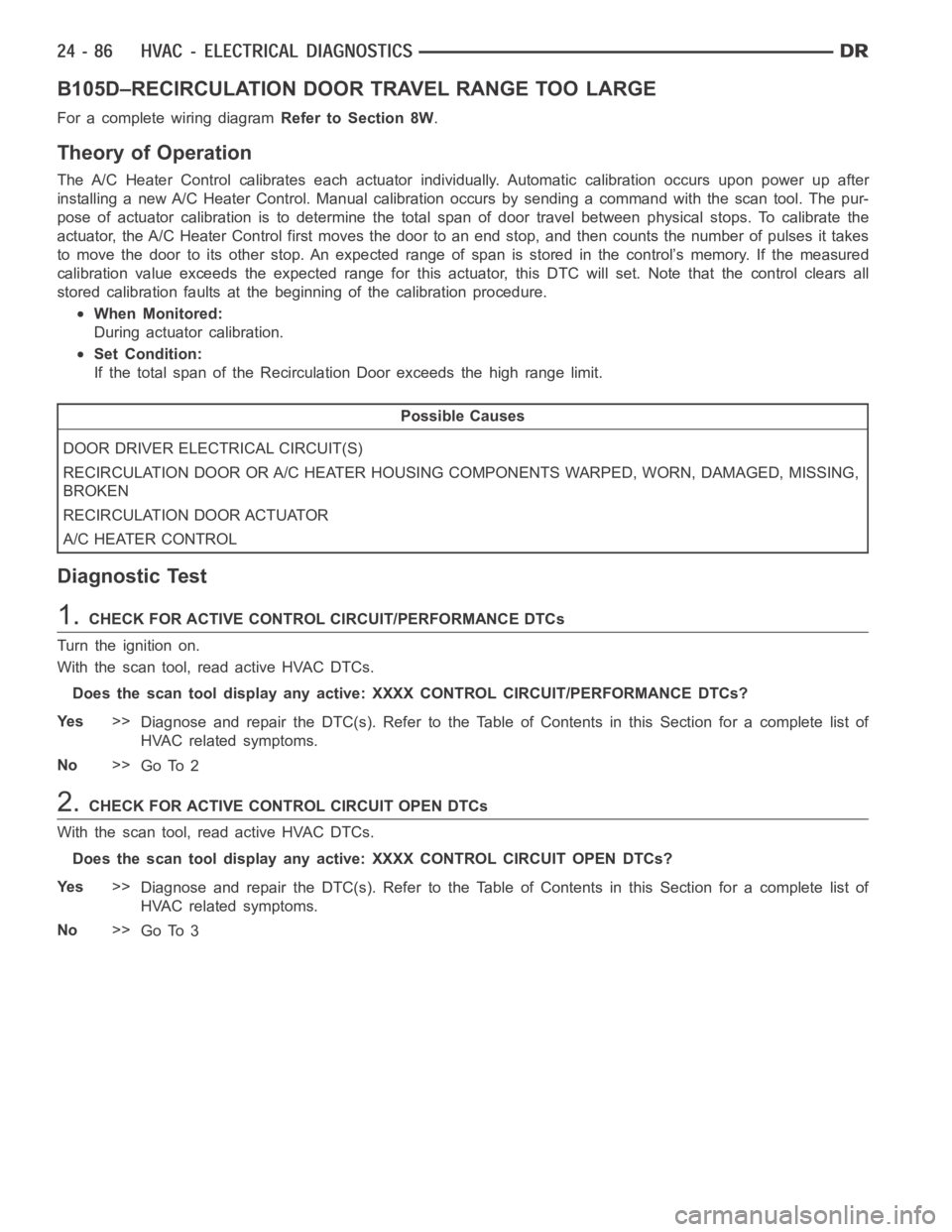
B105D–RECIRCULATION DOOR TRAVEL RANGE TOO LARGE
For a complete wiring diagramRefer to Section 8W.
Theory of Operation
The A/C Heater Control calibrates each actuator individually. Automaticcalibration occurs upon power up after
installing a new A/C Heater Control. Manual calibration occurs by sendinga command with the scan tool. The pur-
pose of actuator calibration is to determine the total span of door travel between physical stops. To calibrate the
actuator, the A/C Heater Control first moves the door to an end stop, and then counts the number of pulses it takes
to move the door to its other stop. An expected range of span is stored in the control’s memory. If the measured
calibration value exceeds the expected range for this actuator, this DTC will set. Note that the control clears all
stored calibration faults at the beginning of the calibration procedure.
When Monitored:
During actuator calibration.
Set Condition:
If the total span of the Recirculation Door exceeds the high range limit.
Possible Causes
DOOR DRIVER ELECTRICAL CIRCUIT(S)
RECIRCULATION DOOR OR A/C HEATER HOUSING COMPONENTS WARPED, WORN, DAMAGED, MISSING,
BROKEN
RECIRCULATION DOOR ACTUATOR
A/C HEATER CONTROL
Diagnostic Test
1.CHECK FOR ACTIVE CONTROL CIRCUIT/PERFORMANCE DTCs
Turn the ignition on.
With the scan tool, read active HVAC DTCs.
Does the scan tool display any active: XXXX CONTROL CIRCUIT/PERFORMANCE DTCs?
Ye s>>
Diagnose and repair the DTC(s). Refer to the Table of Contents in this Section for a complete list of
HVAC related symptoms.
No>>
Go To 2
2.CHECK FOR ACTIVE CONTROL CIRCUIT OPEN DTCs
With the scan tool, read active HVAC DTCs.
Does the scan tool display any active: XXXX CONTROL CIRCUIT OPEN DTCs?
Ye s>>
Diagnose and repair the DTC(s). Refer to the Table of Contents in this Section for a complete list of
HVAC related symptoms.
No>>
Go To 3
Page 4928 of 5267
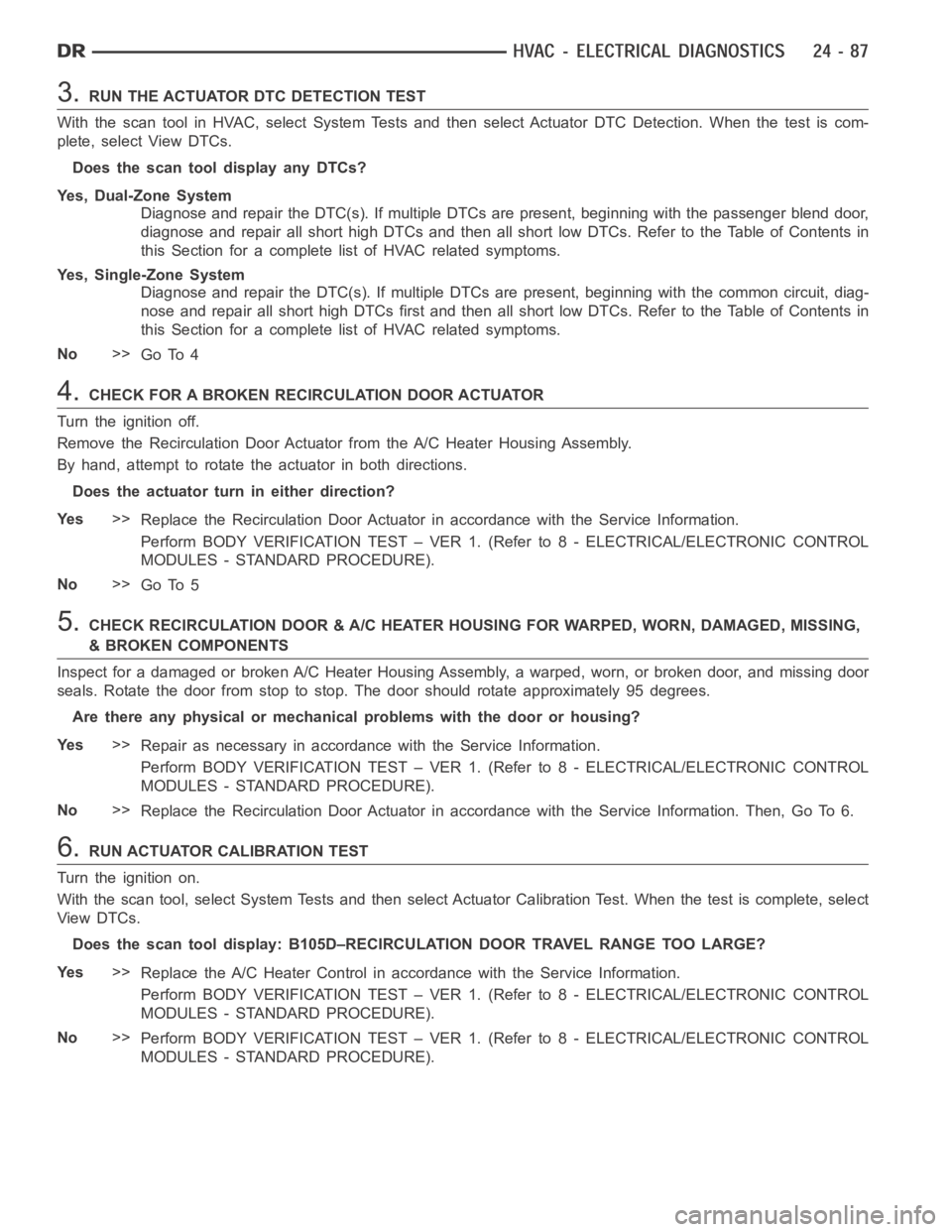
3.RUN THE ACTUATOR DTC DETECTION TEST
With the scan tool in HVAC, select System Tests and then select Actuator DTCDetection. When the test is com-
plete, select View DTCs.
Does the scan tool display any DTCs?
Yes, Dual-Zone System
Diagnose and repair the DTC(s). If multiple DTCs are present, beginning with the passenger blend door,
diagnose and repair all short high DTCs and then all short low DTCs. Refer tothe Table of Contents in
this Section for a complete list of HVAC related symptoms.
Yes, Single-Zone System
Diagnose and repair the DTC(s). If multiple DTCs are present, beginning with the common circuit, diag-
nose and repair all short high DTCs first and then all short low DTCs. Refer to the Table of Contents in
this Section for a complete list of HVAC related symptoms.
No>>
Go To 4
4.CHECK FOR A BROKEN RECIRCULATION DOOR ACTUATOR
Turn the ignition off.
Remove the Recirculation Door Actuator from the A/C Heater Housing Assembly.
By hand, attempt to rotate the actuator in both directions.
Does the actuator turn in either direction?
Ye s>>
Replace the Recirculation Door Actuator in accordance with the Service Information.
Perform BODY VERIFICATION TEST – VER 1. (Refer to 8 - ELECTRICAL/ELECTRONIC CONTROL
MODULES - STANDARD PROCEDURE).
No>>
Go To 5
5.CHECK RECIRCULATION DOOR & A/C HEATER HOUSING FOR WARPED, WORN, DAMAGED, MISSING,
& BROKEN COMPONENTS
Inspect for a damaged or broken A/C Heater Housing Assembly, a warped, worn, or broken door, and missing door
seals. Rotate the door from stop to stop. The door should rotate approximately 95 degrees.
Are there any physical or mechanical problems with the door or housing?
Ye s>>
Repair as necessary in accordance with the Service Information.
Perform BODY VERIFICATION TEST – VER 1. (Refer to 8 - ELECTRICAL/ELECTRONIC CONTROL
MODULES - STANDARD PROCEDURE).
No>>
Replace the Recirculation Door Actuator in accordance with the Service Information. Then, Go To 6.
6.RUN ACTUATOR CALIBRATION TEST
Turn the ignition on.
With the scan tool, select System Tests and then select Actuator Calibration Test. When the test is complete, select
View DTCs.
Does the scan tool display: B105D–RECIRCULATION DOOR TRAVEL RANGE TOO LARGE?
Ye s>>
Replace the A/C Heater Control in accordance with the Service Information.
Perform BODY VERIFICATION TEST – VER 1. (Refer to 8 - ELECTRICAL/ELECTRONIC CONTROL
MODULES - STANDARD PROCEDURE).
No>>
Perform BODY VERIFICATION TEST – VER 1. (Refer to 8 - ELECTRICAL/ELECTRONIC CONTROL
MODULES - STANDARD PROCEDURE).
Page 4936 of 5267
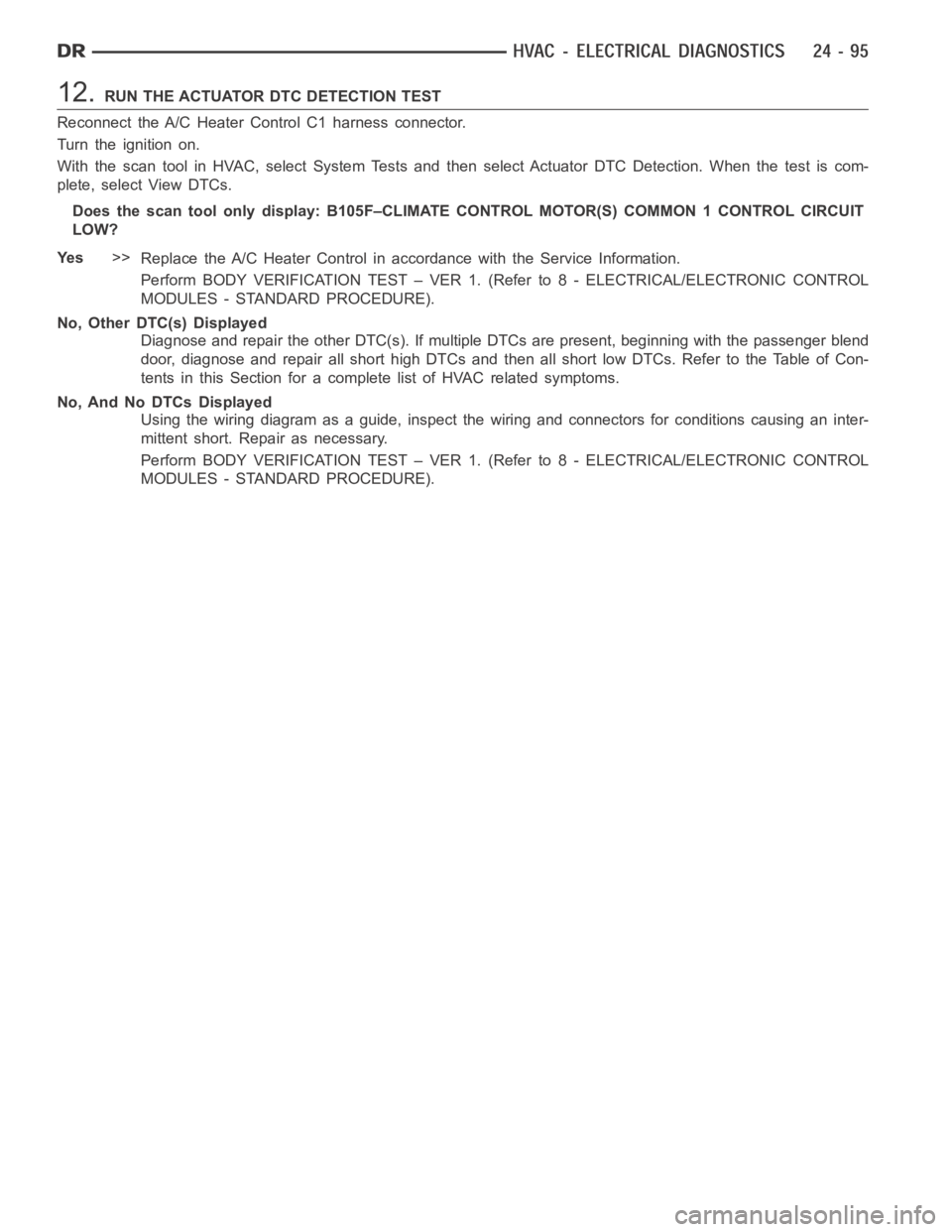
12.RUN THE ACTUATOR DTC DETECTION TEST
Reconnect the A/C Heater Control C1 harness connector.
Turn the ignition on.
With the scan tool in HVAC, select System Tests and then select Actuator DTCDetection. When the test is com-
plete, select View DTCs.
Does the scan tool only display: B105F–CLIMATE CONTROL MOTOR(S) COMMON 1 CONTROL CIRCUIT
LOW?
Ye s>>
Replace the A/C Heater Control in accordance with the Service Information.
Perform BODY VERIFICATION TEST – VER 1. (Refer to 8 - ELECTRICAL/ELECTRONIC CONTROL
MODULES - STANDARD PROCEDURE).
No, Other DTC(s) Displayed
Diagnose and repair the other DTC(s). If multiple DTCs are present, beginning with the passenger blend
door, diagnose and repair all short high DTCs and then all short low DTCs. Refer to the Table of Con-
tents in this Section for a complete list of HVAC related symptoms.
No, And No DTCs Displayed
Using the wiring diagram as a guide, inspect the wiring and connectors for conditions causing an inter-
mittent short. Repair as necessary.
Perform BODY VERIFICATION TEST – VER 1. (Refer to 8 - ELECTRICAL/ELECTRONIC CONTROL
MODULES - STANDARD PROCEDURE).
Page 4943 of 5267

10.RUN THE ACTUATOR DTC DETECTION TEST
Reconnect the A/C Heater Control C1 harness connector.
Turn the ignition on.
With the scan tool in HVAC, select System Tests and then select Actuator DTCDetection. When the test is com-
plete, select View DTCs.
Does the scan tool only display: B105F–CLIMATE CONTROL MOTOR(S) COMMON 1 CONTROL CIRCUIT
LOW?
Ye s>>
Replace the A/C Heater Control in accordance with the Service Information.
Perform BODY VERIFICATION TEST – VER 1. (Refer to 8 - ELECTRICAL/ELECTRONIC CONTROL
MODULES - STANDARD PROCEDURE).
No, Other DTC(s) Displayed
Diagnose and repair the other DTC(s). If multiple DTCs are present, beginning with the common circuit,
diagnose and repair all short high DTCs and then all short low DTCs. Refer tothe Table of Contents in
this Section for a complete list of HVAC related symptoms.
No, And No DTCs Displayed
Using the wiring diagram as a guide, inspect the wiring and connectors for conditions causing an inter-
mittent short. Repair as necessary.
Perform BODY VERIFICATION TEST – VER 1. (Refer to 8 - ELECTRICAL/ELECTRONIC CONTROL
MODULES - STANDARD PROCEDURE).
Page 4945 of 5267

3.CHECK FOR NORMAL A/C MODE SWITCH & STATUS INDICATOR FUNCTION
Turn the ignition on.
Turn the blower control on.
Press the A/C mode switch on and off several times while observing the A/C status indicator.
Does the A/C status indicator turn on and off with respect to the switch position?
Ye s>>
Go To 4
No>>
Replace the A/C Heater Control in accordance with the Service Information.
Perform BODY VERIFICATION TEST – VER 1. (Refer to 8 - ELECTRICAL/ELECTRONIC CONTROL
MODULES - STANDARD PROCEDURE).
4.VERIFY THAT DTC B1001–A/C SWITCH REQUEST INPUT CIRCUIT LOW IS STILL ACTIVE
Turn the blower control off.
With the scan tool, erase HVAC DTCs.
Turn the ignition off, wait 10 seconds, and then turn the ignition on. Wait two minutes before proceeding.
With the scan tool, read HVAC DTCs.
Does the scan tool display active: B1001–A/C SWITCH REQUEST INPUT CIRCUITLOW?
Ye s>>
Replace the A/C Heater Control in accordance with the Service Information.
Perform BODY VERIFICATION TEST – VER 1. (Refer to 8 - ELECTRICAL/ELECTRONIC CONTROL
MODULES - STANDARD PROCEDURE).
No>>
Perform BODY VERIFICATION TEST – VER 1. (Refer to 8 - ELECTRICAL/ELECTRONIC CONTROL
MODULES - STANDARD PROCEDURE).
Page 4947 of 5267
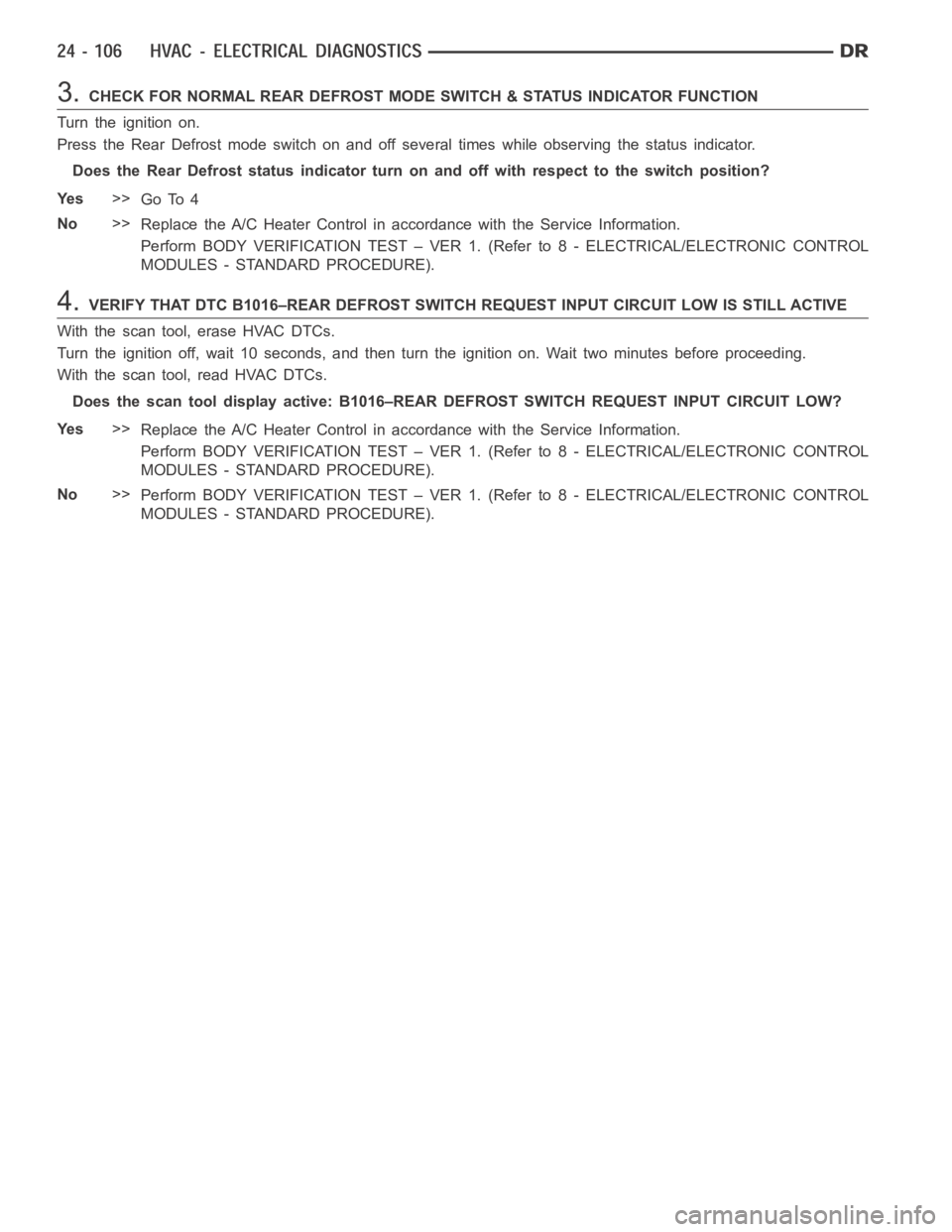
3.CHECK FOR NORMAL REAR DEFROST MODE SWITCH & STATUS INDICATOR FUNCTION
Turn the ignition on.
Press the Rear Defrost mode switch on and off several times while observingthe status indicator.
Does the Rear Defrost status indicator turn on and off with respect to the switch position?
Ye s>>
Go To 4
No>>
Replace the A/C Heater Control in accordance with the Service Information.
Perform BODY VERIFICATION TEST – VER 1. (Refer to 8 - ELECTRICAL/ELECTRONIC CONTROL
MODULES - STANDARD PROCEDURE).
4.VERIFY THAT DTC B1016–REAR DEFROST SWITCH REQUEST INPUT CIRCUIT LOW IS STILL ACTIVE
With the scan tool, erase HVAC DTCs.
Turn the ignition off, wait 10 seconds, and then turn the ignition on. Wait two minutes before proceeding.
With the scan tool, read HVAC DTCs.
Does the scan tool display active: B1016–REAR DEFROST SWITCH REQUEST INPUT CIRCUIT LOW?
Ye s>>
Replace the A/C Heater Control in accordance with the Service Information.
Perform BODY VERIFICATION TEST – VER 1. (Refer to 8 - ELECTRICAL/ELECTRONIC CONTROL
MODULES - STANDARD PROCEDURE).
No>>
Perform BODY VERIFICATION TEST – VER 1. (Refer to 8 - ELECTRICAL/ELECTRONIC CONTROL
MODULES - STANDARD PROCEDURE).
Page 4949 of 5267

When Monitored:
With the ignition on.
Set Condition:
If the Evaporator Temperature Sensor input is out of range toward the low voltage threshold, (A/D counts reach
low threshold of 3). This DTC has a maturing time of 5 seconds and a de-maturing time of 10 seconds. If the
DTC’s status changes from active to stored it will stay in memory for 100 ignition cycles.
Possible Causes
(C21) EVAPORATOR TEMPERATURE SENSOR SIGNAL CIRCUIT SHORTED TO GROUND
(C21) EVAPORATOR TEMPERATURE SENSOR SIGNAL CIRCUIT SHORTED TO (C121) SENSOR GROUND
CIRCUIT
EVAPORATOR TEMPERATURE SENSOR
A/C HEATER CONTROL
NOTE: This DTC must be active for the results of this test to be valid. Do not perform this test if this DTC
is stored. Refer to HVAC System Test for stored DTC test procedures.
Diagnostic Test
1.CHECK (C21) EVAPORATOR TEMPERATURE SENSOR SIGNAL CIRCUIT VOLTAGE WITH THE SENSOR
DISCONNECTED
Turn the ignition off.
Disconnect the Evaporator Temperature Sensor harness connector.
Turn the ignition on.
With the scan tool in Data Display, read the Evaporator Temperature
Sensor voltage.
Is the voltage 4.9 volts or greater?
Ye s>>
Replace the Evaporator Temperature Sensor in accordance
with the Service Information.
Perform BODY VERIFICATION TEST – VER 1. (Refer to 8
- ELECTRICAL/ELECTRONIC CONTROL MODULES -
STANDARD PROCEDURE).
No>>
Go To 2
Page 4953 of 5267

2.CHECK (C21) EVAPORATOR TEMPERATURE SENSOR SIGNAL CIRCUIT & (C121) SENSORGROUND
CIRCUIT FUNCTION
Turn the ignition off.
Reconnect the A/C Heater Control C1 harness connector.
Disconnect the Evaporator Temperature Sensor harness connector.
Connect a jumper wire between the (C21) Evaporator Temperature Sen-
sor Signal circuit and the (C121) Sensor Ground circuit in the Evapora-
tor Temperature Sensor harness connector.
Turn the ignition on.
With the scan tool in Data Display, read the Evaporator Temperature
Sensor voltage.
Is the voltage below 0.10 volts?
Ye s>>
Replace the Evaporator Temperature Sensor in accordance
with the Service Information.
Perform BODY VERIFICATION TEST – VER 1. (Refer to 8
- ELECTRICAL/ELECTRONIC CONTROL MODULES -
STANDARD PROCEDURE).
No>>
Go To 3
3.CHECK (C21) EVAPORATOR TEMPERATURE SENSOR SIGNAL CIRCUIT FOR AN OPEN
Turn the ignition off.
Remove the jumper wire from the Evaporator Temperature Sensor har-
ness connector.
Disconnect the A/C Heater Control C1 harness connector.
Measure the resistance of the (C21) Evaporator Temperature Sensor
Signal circuit between the Evaporator Temperature Sensor harness con-
nector and the A/C Heater Control C1 harness connector.
Is the resistance below 5.0 ohms?
Ye s>>
Go To 4
No>>
Repair the (C21) Evaporator Temperature Sensor Signal cir-
cuit for an open.
Perform BODY VERIFICATION TEST – VER 1. (Refer to 8
- ELECTRICAL/ELECTRONIC CONTROL MODULES -
STANDARD PROCEDURE).